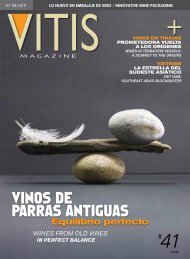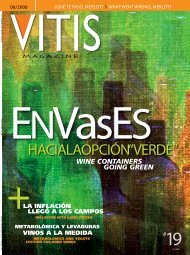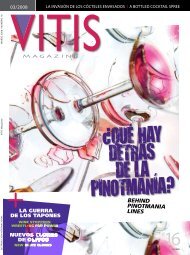You also want an ePaper? Increase the reach of your titles
YUMPU automatically turns print PDFs into web optimized ePapers that Google loves.
las dUnas de ica<br />
dientes de la cultura de los paracas, los pishcos, que elaboraban unas hermosas<br />
ánforas con cierta reminiscencia de jarrones griegos. en esas mismas<br />
vasijas se empezó a guardar más tarde el producto de la destilación<br />
de las uvas, el pisco, por lo que esta palabra sirvió para nombrar tanto a<br />
los elaboradores como al continente y al contenido.<br />
Una rápida mirada al mapa del perú haría pensar que el territorio<br />
geográfico en el que se circunscribe la zona pisquera es tremendamente<br />
vasto. pero en la práctica, se trata de una gran región, casi desértica, atravesada<br />
por algunos riachuelos que sólo traen hilitos de agua provenientes<br />
de glaciares cordilleranos. en torno a ellos se forman pequeños valles,<br />
muy verdes y llenos de vegetación, que, sumados, no dan una superficie<br />
demasiado grande.<br />
la corriente de humboldt, que fluye hasta poco más al norte de lima,<br />
hace que perú tenga en esa zona arenas secas, frío en las noches y calor<br />
en el día en vez del clima tropical que le correspondería por latitud. sin<br />
embargo, allí donde hay agua para regar, esas arenas son estupendas para<br />
producir uvas pisqueras, de las cuales incluso se pueden obtener hasta<br />
the producers, the containers and the contents.<br />
a quick glance at the map of Peru might suggest that<br />
the area encompassing the pisco-producing zones is very<br />
widespread. but in actuality this is a very vast mostly deserted<br />
region sprinkled by a few streams carrying elusive ropes of<br />
water from mountain glaciers. along them we find small,<br />
intensely green valleys with plentiful vegetation, but their<br />
added areas are not at all impressive.<br />
The Humboldt current, which reaches the area of Lima<br />
before turning west, makes this area of Peru a zone of<br />
dry sands, cold nights and hot days instead of the tropical<br />
weather one might expect given the latitude. However,<br />
in those areas with enough water the sand turns into an<br />
excellent culture land for pisco grapes, which may even yield<br />
two crops every three years. The aim is exactly the opposite<br />
as everywhere else in the wine industry, which is mostly<br />
driven by high yields to deter concentration, and high brix<br />
readings to reach the alcohol degrees desired.<br />
HIGH-END PISCOS<br />
While some time ago pisco lost some of its popularity<br />
among Peruvian consumers (they allegedly envy the<br />
amount of liters the chilean domestic market is capable<br />
of absorbing), today Peru is determined to restore its<br />
status, and therefore it has begun producing it with quality<br />
standards that permit to obtain high-end distillates. Luckily<br />
enough, because tasting a top-tier pisco equals entering a<br />
world of fascinating and sophisticated aromas and flavors<br />
that are worth those of any other more renowned tipple.<br />
Like its three elder cousins – cognac, armagnac and<br />
Xeres brandy – pisco is a noble spirit. it is an “eau de vie de<br />
vin” (wine spirit) in whose production there is no room for<br />
residues like grape skins, which are used to produce grappa.<br />
unlike chilean pisco, Peruvians decided that their pisco<br />
should be colorless, limpid and translucent, making it shine<br />
with a glow of its own. “silver dug out of the andes depths<br />
and diluted in a bain marie…” poetically says Johnny schuler.<br />
Hence the criticism of this Peruvian pisco promoter for,<br />
among other things, our insistence on keeping both piscos<br />
isolated instead of joining efforts with Peru to present this<br />
product as “the fine distillate from the new World”.<br />
The distillation of Peruvian pisco is a process known in<br />
the technical parlance as “distilled to proof”. it begins by<br />
discarding the distillation head and tail, using only water to<br />
obtain the alcohol content required by law (between 38º and<br />
48º). Therefore, instead of ranking piscos by their alcohol<br />
contents as we do in chile, they classify them horizontally,<br />
by variety. only eight varieties are permitted: four aromatic<br />
and four non-aromatic ones. among the latter, perhaps the<br />
most widely recognized is Quebrantal, also known as negra<br />
criolla. all these varieties give birth to four large types of<br />
pisco: aromatic, non-aromatic, acholado (blends of aromatic<br />
and non-aromatic grapes in different proportions) and green<br />
musts. Green must is a distillate produced from sweet must,<br />
▼ <strong>Vitis</strong> <strong>Magazine</strong> l novieMbre 2008 l 51






